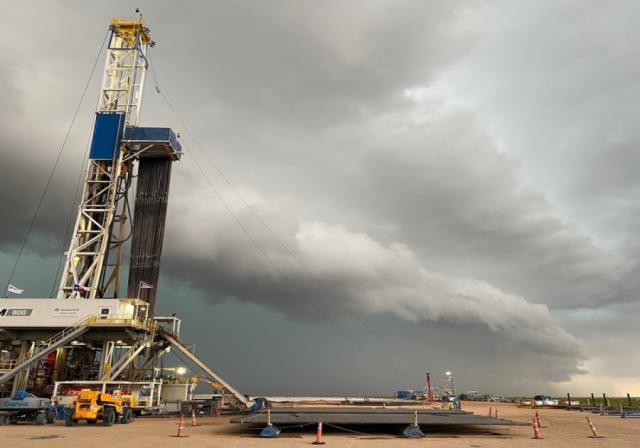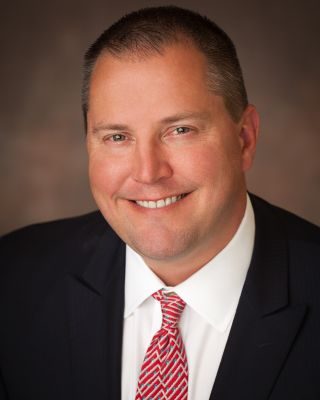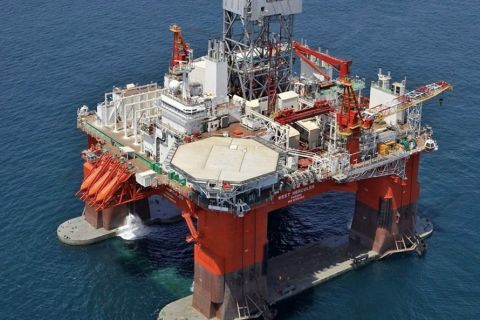
Drilling in the Permian Basin has been an area of focus for U.S. Energy Development Corp. Pictured is the Nabors 1206 Storm rig. (Source: U.S. Energy Development Corp.)
[Editor's note: A version of this story appears in the November 2020 issue of Oil and Gas Investor magazine. It was originally published Oct. 6, 2020. Subscribe to the magazine here.]
Where there’s a will there’s a way, as the saying goes, even in the oil patch during times of thinned budgets, limited access to capital and growing decline rates.
The way to lower costs and shared risk may be through U.S. Energy Development Corp. for some oil and gas companies.
The Texas-headquartered private is leveraging its 40 years of expertise developing oil and natural gas assets to acquire interest and form partnerships to make projects happen. The company, which specializes in direct energy investments, said it has deployed more than $1.5 billion on behalf of its partners, drilling more than 2,400 wells in North America.
“We look at over 300 deals on an annual basis, and this year’s been no exception,” Jordan Jayson, CEO of U.S. Energy Development Corp., told Hart Energy. “We’ve seen great opportunities and we’ve been approached by several companies—large and small—for potential joint venture opportunities.”
Among its latest moves was acquiring an $8.5 million interest in Shell Oil Co.’s Columbia Project in the Permian Basin. U.S. Energy’s role in the project, which carries a $24.1 million total development cost, includes drilling three horizontal wells targeting oil in the Wolfcamp formation in West Texas’ Loving County.
U.S. Energy raises capital via private placements, special purpose vehicles and institutional investors and family offices, Jayson said.
Despite being in a strong financial position and cash flow positive, he admits that raising capital has been challenging in today’s environment. But the search continues for quality projects with favorable returns.
“We’re actively in the market looking for additional acquisitions and strategic joint venture partners,” he said. “We’re looking for additional opportunities like Colombia, and we’re empathetic to the current status of the energy industry in North America and hope for a swift recovery.”
Focus, he added, is primarily on areas where wells will come online within the next 12 months.
Hart Energy recently spoke with Jayson, who shared more insight about the company, its strategy and latest pursuits.

Hart Energy: The latest collapse in oil prices prompted U.S. oil and gas companies to cut spending as the industry overall continues to see investment fall. What keeps U.S. Energy Development Corp. investing in U.S. shale plays?
Jayson: Our team feels that there are several basins where the economics of U.S. shale remain attractive even at these prices. For companies like U.S. Energy, we have a low-cost structure and we also have the ability to structure deals creatively. And so that’s allowed us to continue to invest in U.S. shale plays even during these lower commodity price cycles.
Hart Energy: I understand that U.S. Energy is currently funding development drilling projects in the Eagle Ford Shale, Denver-Julesburg Basin and the Powder River Basin. Why these areas and why now of all times?
Jayson: They are focus areas for us right now due to the attractive rates of return at today’s strip pricing. We’re also seeing a trend of a number of companies that are selling down their nonoperating working interest in these areas. I think we’ve looked at close to $2 billion dollars’ worth of developmental drilling deals over the past nine months. And these basins typically have enough supporting data to reduce geological and operational risk to a point that makes it attractive for ourselves and our partners.
Hart Energy: Tell me more about your typical deal structure. What are some of the ways you’ve structured deals creatively?
Jayson: U.S. Energy is focused on structuring deals that are mutually beneficial to all parties. Our flexibility allows us to structure deals in a variety of manners—from traditional joint development agreements and farm-ins as the operator, to nonoperated working interest and PDP acquisitions, as well as wellbore-only arrangements.
Hart Energy: When looking to acquire assets or interest in assets, what qualities do U.S. Energy look for? What is your business strategy?
Jayson: Firstly, the return profiles of the assets that we’re looking at must meet our investment committee’s objectives and also our partners’ objectives. We’re looking for low geological and operational risk. We’re looking for strong offsetting production or wellbore control. Good takeaway capacity from a midstream standpoint.
Hart Energy: How do your economics work at today’s oil and gas prices?
Jayson: Well, all of our existing PDP is cash flow positive at today’s current strip. But we monitor our operating wells daily and monitor whether they’re free cash flow positive or negative. If they are negative, we react immediately on a daily basis and shut those wells in. With respect to new ventures, we don’t acquire assets unless they support our necessary return thresholds.
Hart Energy: What are those thresholds?
Jayson: Those would be a return on investment greater than 1.5X; internal rates of return greater than 20%. They’re not generic metrics; those are metrics that we use as an investment committee prior to making decisions.
Hart Energy: Are most of your assets conventional or unconventional? Do you have any appetite for more unconventional assets? Why or why not?
Jayson: Being a 40-year-old firm—we’re celebrating our 40th anniversary this year—our historical assets were conventional. And over the past decade, we’ve gradually moved into the shale plays and unconventional assets. We still have an appetite for unconventional assets. We currently operate 800 vertical wells—our conventional wells—in Appalachia, and we’re currently looking at other projects that are conventional at this point in time as well. So, we’re a bit agnostic to unconventional versus conventional. More of our team’s focus is on the return on investment and the basin.
Hart Energy: Let’s talk about your most recent announced deal in the Permian Basin, acquiring interest in Shell’s Columbia project. Can you tell me more about Columbia and how that transaction came about?
Jayson: U.S. Energy’s built several strong relationships with different large operators. As these operators choose to sell down their nonoperating working interest, U.S. Energy has been a potential acquirer of the nonoperating interests that some of these larger operators are choosing to divest of versus participate.
Hart Energy: Can you tell me a little bit more about the project itself? What are the breakevens? How much oil will be initially produced?
Jayson: The project is in Loving County, Texas. Three wells have been drilled targeting the Wolfcamp horizontally. The wells are scheduled to be put in production in Q4 of 2020. The breakevens are roughly $30 per barrel of oil. I don’t have a number for what we anticipate for our initial IP rates but we’ve seen wells in that area come in well above 1,000 barrels of oil per day on average.
Hart Energy: Will you also provide an update on your three-well development in Ward County?
Jayson: We entered into an agreement to buy an asset in Ward County last year. It had production and also some undeveloped acreage. Earlier this year, we finished drilling a three-well pad that was targeting the Wolfcamp B. We had great drilling success on average 46% faster than the acquired PDP while we reduced costs by 30%or greater. We anticipate completing those wells in Q4 of 2020 and anticipate drilling up to six wells in 2021 in our Ward County prospect.
Hart Energy: Looking specifically at the Permian Basin, what development challenges and opportunities could lie ahead in the basin?
Jayson: I would say with the challenges our biggest challenges in the Permian Basin are takeaway capacity, associated transportation costs and saltwater disposal costs. I think that’s consistent for most operators or possibly for some operators as well in the Permian Basin. What opportunities lie ahead? We continue to see a great amount of deal flow on a weekly basis in the Permian Basin right now. We don’t anticipate that slowing down in the near future and that creates opportunities for U.S. Energy.
Hart Energy: What are your thoughts on well spacing? Do you think high-density spacing can still work or do you think that tighter spacing has been too aggressive?
Jayson: We’re in a unique position where most of our investments are at the well level rather than the asset level. … We’re focused on the drilling and completing of wells that meet our return profile rather than increasing our well count to maximize reserves. So, we would prefer to see greater spacing. But it depends [on the] basin. The technology is changing so rapidly. In some areas, as you’re aware, tighter spacing has been very, very successful. In other areas, ourselves and our joint venture partners have decided that it was in the best interest for returns to increase spacing. So, we monitor it and study it closely and we feel that it is specific on the area within a basin. But we would prefer generally for a wider spacing, for greater spacing, rather than the aggressive spacing that we’ve seen over the past several years.
Hart Energy: Some analysts have forecast that frac HHP demand won’t recover to 2019 levels until 2025? What are your views on the outlook for hydraulic fracturing activity?
Jayson: I’ll limit my answer to the Permian Basin because that’s where we’re most active right now. U.S. Energy is not an oilfield service company, but obviously, our activity impacts oilfield service companies. We anticipate that there is plenty of running room in the Permian for additional drilling that will support greater horsepower needs. As prices stabilize and potentially escalate, we believe that the activity in the Permian is going to continue to grow and the need for horsepower will continue to grow in the Permian.
Hart Energy: How do you see U.S. Energy evolving within the next five years? Does the future include more acquisitions and partnerships like the one with Shell?
Jayson: I would imagine that U.S. Energy will remain active in the E&P market. We’re looking for additional partnerships like the one that we’ve established with Shell. We’re in a strong financial position and have access to additional liquidity to put to work in these types of partnerships and joint ventures. We’re in the best financial position that we’ve been in 40 years, so we’ll hopefully continue to build upon that as we move forward from the current market conditions that we’re in today.
Hart Energy: How much free cash flow does U.S. Energy have? Can you give a brief snapshot of financials?
Jayson: We are a private company and we do not disclose our financials. What I can say is we have remained profitable and free cash flow positive throughout 2020. Our debt has been reduced by 60% over the past several years while continuing to grow our reserves. These actions have put our team in a unique position to be able to transact during challenging times our industry is experiencing.
Hart Energy: Is there anything else you want the oil and gas community to know about U.S. Energy?
Jayson: I would just add on one thing. The reason U.S. Energy is in our current financial position is because of our laser focus on driving free cash flow and minimizing our leverage over the past 5 years. I think our team’s done a great job of navigating the last two downcycles, and I think that experience paid off during COVID; whereas, in 2015 we didn’t react as quickly as we did as COVID escalated. I give all the credit to our team in moving as quickly as we did to monitor free cash flow and maintain free cash flow throughout Q1 and Q2 of 2020.
Recommended Reading
Deepwater Roundup 2024: Offshore Australasia, Surrounding Areas
2024-04-09 - Projects in Australia and Asia are progressing in part two of Hart Energy's 2024 Deepwater Roundup. Deepwater projects in Vietnam and Australia look to yield high reserves, while a project offshore Malaysia looks to will be developed by an solar panel powered FPSO.
E&P Highlights: March 11, 2024
2024-03-11 - Here’s a roundup of the latest E&P headlines, including a new bid round offshore Bangladesh and new contract awards.
Orange Basin Serves Up More Light Oil
2024-03-15 - Galp’s Mopane-2X exploration well offshore Namibia found a significant column of hydrocarbons, and the operator is assessing commerciality of the discovery.
E&P Highlights: March 4, 2024
2024-03-04 - Here’s a roundup of the latest E&P headlines, including a reserves update and new contract awards.
Sangomar FPSO Arrives Offshore Senegal
2024-02-13 - Woodside’s Sangomar Field on track to start production in mid-2024.





